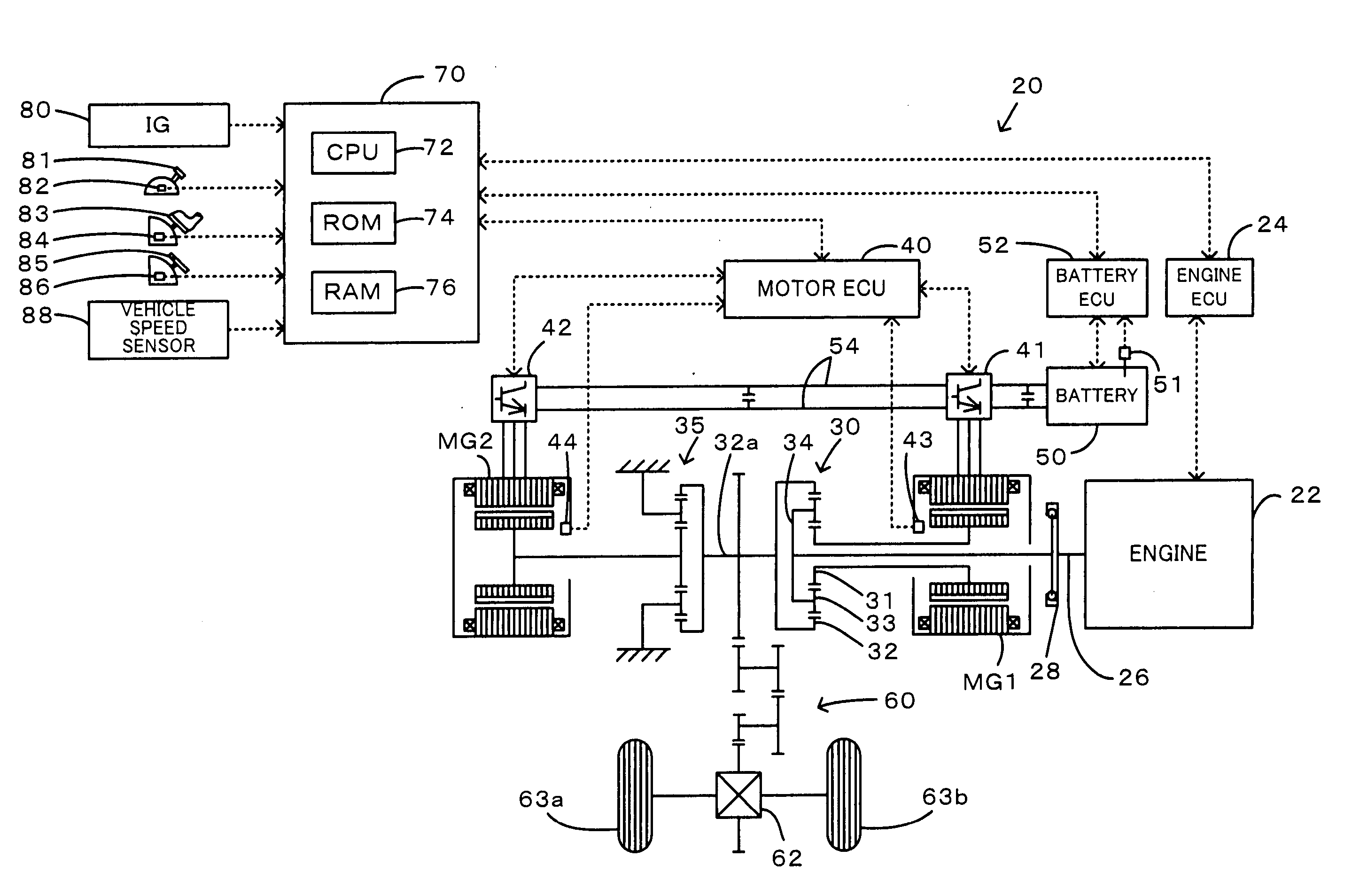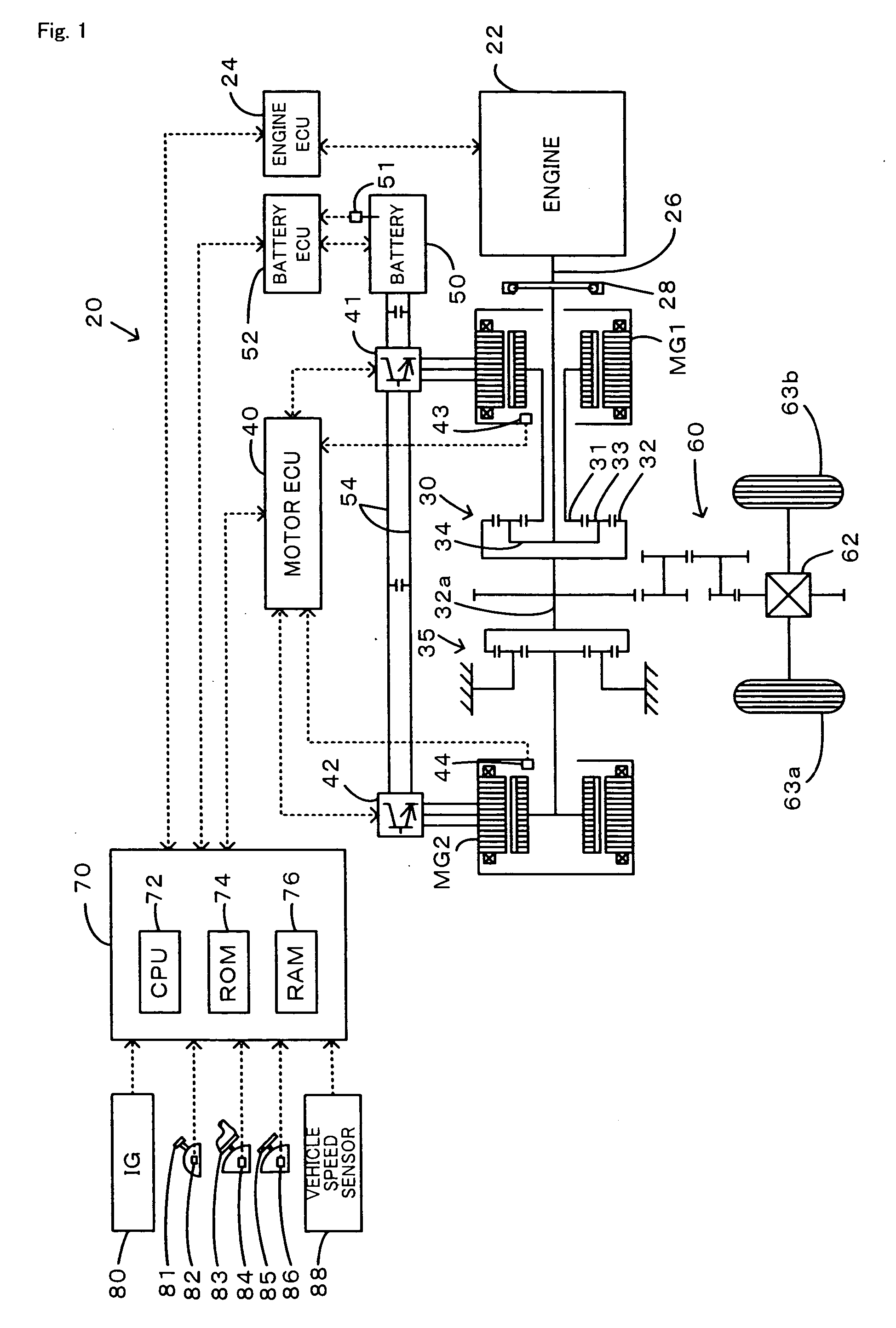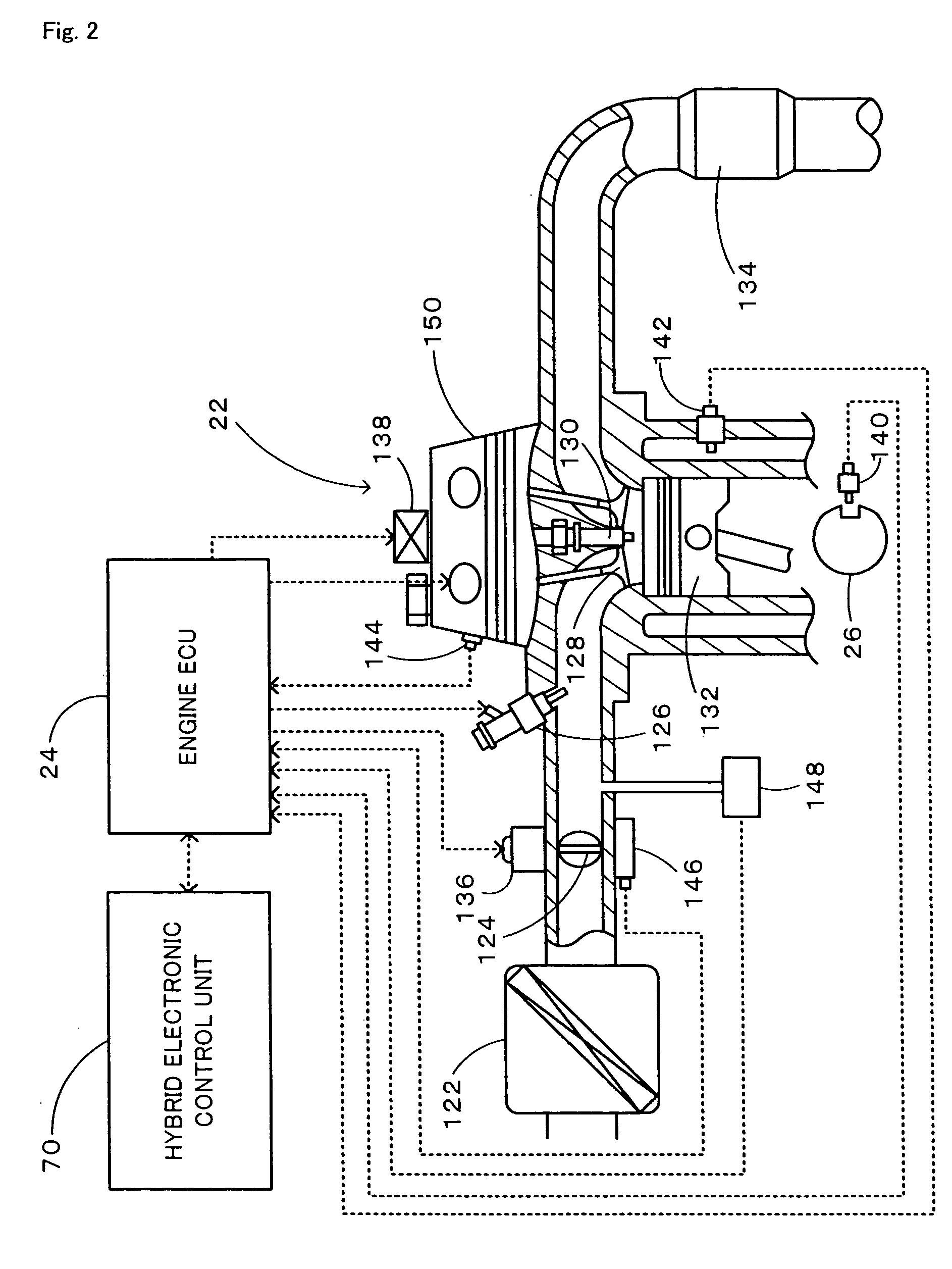[0006] The power output apparatus of the invention, the motor vehicle equipped with the power output apparatus, and the control method of the power output apparatus thus aim to prevent frequent
changeover between the stop and the start of an
internal combustion engine in a cold environment. The power output apparatus of the invention, the motor vehicle equipped with the power output apparatus, and the control method of the power output apparatus also aim to ensure output of a required level of power to a
drive shaft even in a cold environment.
[0009] In the first power output apparatus of the invention, the ordinary control of the
internal combustion engine and the
electric power-mechanical power input-output module, which outputs at least part of the output power of the
internal combustion engine to the
drive shaft through input and output of electric powers and mechanical powers, is executed in the ordinary state to drive the internal
combustion engine at the target drive point, which is set in response to the
power demand to be output to the
drive shaft, and to ensure output of the required power corresponding to the
power demand to the drive shaft. In the non-ordinary state where execution of the ordinary control causes the output
power level of the internal
combustion engine to exceed the target power, which is set in response to the
power demand to be output to the drive shaft, the non-ordinary control of the internal
combustion engine and the electric power-mechanical power input-output module is executed to drive the internal combustion engine at the specific drive point of making the output power level of the internal combustion engine approach to the target power, while keeping the level of the
throttle opening at the target drive point, and to ensure the output of the required power corresponding to the power demand to the drive shaft. Such control effectively restricts an increase in electric power for charging the accumulator module, due to an increase in output power level of the internal combustion engine above the target power. The first power output apparatus of the invention thus desirably prevents frequent changeover between the stop of the internal combustion engine to prevent
overcharge of the accumulator module and the start of the internal combustion engine to charge the accumulator module in response to a requirement for activation of auxiliary machinery, while ensuring output of a required level of power corresponding to the power demand to the drive shaft.
[0017] In the second power output apparatus of the invention, the ordinary control of the internal combustion engine and the electric power-mechanical power input-output module, which outputs at least part of the output power of the internal combustion engine to the drive shaft through input and output of electric powers and mechanical powers, is executed in the ordinary state to drive the internal combustion engine at the target drive point, which is set in response to the power demand to be output to the drive shaft, and to ensure output of the required power corresponding to the power demand to the drive shaft. In the non-ordinary state where execution of the ordinary control causes the output power level of the internal combustion engine to exceed the target power, which is set in response to the power demand to be output to the drive shaft, the non-ordinary control of the internal combustion engine and the electric power-mechanical power input-output module is executed to keep a selected driving parameter among multiple driving parameters, which represent operating conditions of the internal combustion engine and include a rotation speed, a torque level, an
ignition timing, intake and exhaust timings, and a
throttle opening, at a current level, while varying at least one driving parameter other than the selected driving parameter, thus driving the internal combustion engine at a specific drive point of making the output power level of the internal combustion engine approach to the target power and ensuring the output of the required power corresponding to the power demand to the drive shaft. Such control effectively restricts an increase in electric power for charging the accumulator module, due to an increase in output power level of the internal combustion engine above the target power. The second power output apparatus of the invention thus desirably prevents frequent changeover between the stop of the internal combustion engine to prevent
overcharge of the accumulator module and the start of the internal combustion engine to charge the accumulator module in response to a requirement for activation of auxiliary machinery, while ensuring output of a required level of power corresponding to the power demand to the drive shaft.
[0019] In the first control method of the invention, the ordinary control of the internal combustion engine and the electric power-mechanical power input-output module, which outputs at least part of the output power of the internal combustion engine to the drive shaft through input and output of electric powers and mechanical powers, is executed in the ordinary state to drive the internal combustion engine at the target drive point, which is set in response to the power demand to be output to the drive shaft, and to ensure output of the required power corresponding to the power demand to the drive shaft. In the non-ordinary state where execution of the ordinary control causes the output power level of the internal combustion engine to exceed the target power, which is set in response to the power demand to be output to the drive shaft, the non-ordinary control of the internal combustion engine and the electric power-mechanical power input-output module is executed to drive the internal combustion engine at the specific drive point of making the output power level of the internal combustion engine approach to the target power, while keeping the level of the
throttle opening at the target drive point, and to ensure the output of the required power corresponding to the power demand to the drive shaft. Such control effectively restricts an increase in electric power for charging the accumulator module, due to an increase in output power level of the internal combustion engine above the target power. The first control method of the invention thus desirably prevents frequent changeover between the stop of the internal combustion engine to prevent
overcharge of the accumulator module and the start of the internal combustion engine to charge the accumulator module in response to a requirement for activation of auxiliary machinery, while ensuring output of a required level of power corresponding to the power demand to the drive shaft.
[0023] In the second control method, the ordinary control of the internal combustion engine and the electric power-mechanical power input-output module, which outputs at least part of the output power of the internal combustion engine to the drive shaft through input and output of electric powers and mechanical powers, is executed in the ordinary state to drive the internal combustion engine at the target drive point, which is set in response to the power demand to be output to the drive shaft, and to ensure output of the required power corresponding to the power demand to the drive shaft. In the non-ordinary state where execution of the ordinary control causes the output power level of the internal combustion engine to exceed the target power, which is set in response to the power demand to be output to the drive shaft, the non-ordinary control of the internal combustion engine and the electric power-mechanical power input-output module is executed to keep a selected driving parameter among multiple driving parameters, which represent operating conditions of the internal combustion engine and include a rotation speed, a torque level, an
ignition timing, intake and exhaust timings, and a
throttle opening, at a current level, while varying at least one driving parameter other than the selected driving parameter, thus driving the internal combustion engine at a specific drive point of making the output power level of the internal combustion engine approach to the target power and ensuring the output of the required power corresponding to the power demand to the drive shaft. Such control effectively restricts an increase in electric power for charging the accumulator module, due to an increase in output power level of the internal combustion engine above the target power. The second control method of the invention thus desirably prevents frequent changeover between the stop of the internal combustion engine to prevent overcharge of the accumulator module and the start of the internal combustion engine to charge the accumulator module in response to a requirement for activation of auxiliary machinery, while ensuring output of a required level of power corresponding to the power demand to the drive shaft.
 Login to View More
Login to View More  Login to View More
Login to View More 


